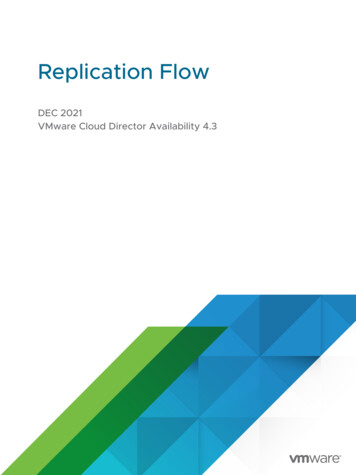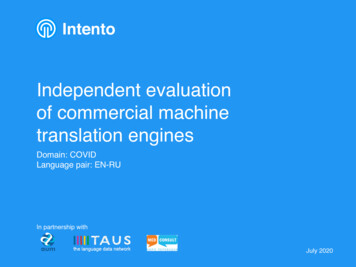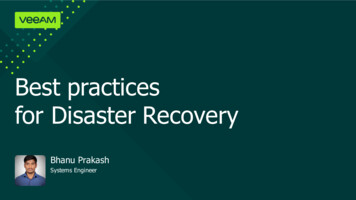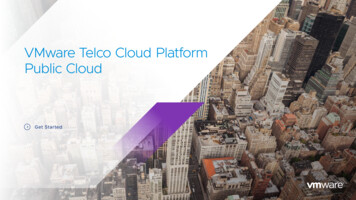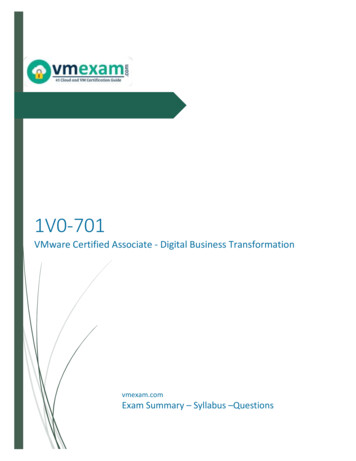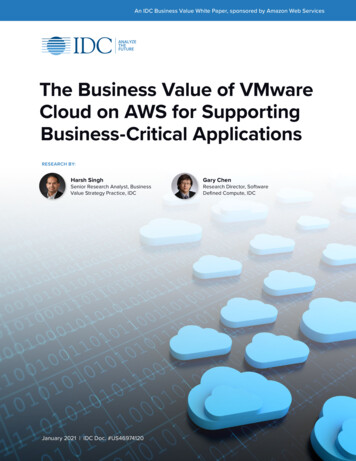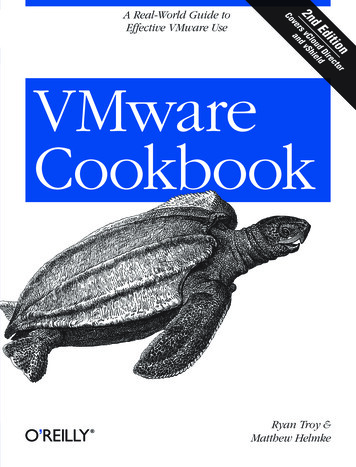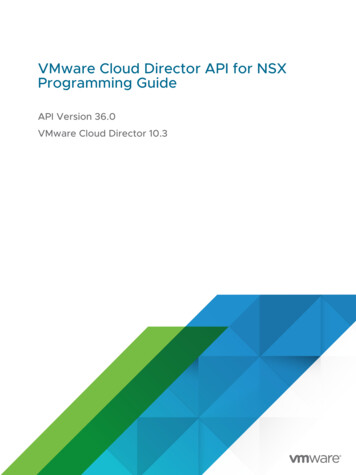
Transcription
VMware Cloud Director API for NSXProgramming GuideAPI Version 36.0VMware Cloud Director 10.3
VMware Cloud Director API for NSX Programming GuideYou can find the most up-to-date technical documentation on the VMware website at:https://docs.vmware.com/VMware, Inc.3401 Hillview Ave.Palo Alto, CA 94304www.vmware.comCopyrightVMware, Inc. 2016-2021 VMware, Inc. All rights reserved. Copyright and trademark information.2
Contents1 About the VMware Cloud Director API for NSX 42 NSX Edge Gateway Management 7Query or Upgrade an Edge GatewayEdge DHCP Services8Edge Firewall ServicesEdge NAT Services71011Edge Routing Services12Edge Load Balancer ServicesEdge SSL VPN ServicesEdge L2 VPN Services131721Edge IPSec VPN Services21Edge Interfaces, Logging, Statistics, and Remote Access Properties223 NSX Distributed Firewall Service 244 NSX Services 28Certificate Management28Applications and Application GroupsSecurity GroupsSecurity Tags3031Grouping ObjectsVMware, Inc.30323
About the VMware Cloud DirectorAPI for NSX1The VMware Cloud Director API for NSX is a proxy API that enables VMware Cloud Director APIclients to make requests to the NSX API.Use this document as a supplement to the NSX vSphere API Guide (NSX version 6.3 or later). Thisdocument lists the subset of NSX API requests supported by the VMware Cloud Director API forNSX and provides information about differences between those requests as they are describedin the NSX API documentation and how you must make them when using the VMware CloudDirector API for NSX.Relationship to the NSX APIThe VMware Cloud Director API for NSX supports a subset of the operations andobjects defined in the NSX vSphere API Guide. The API supports NSX 6.3 and 6.4.You can download the NSX vSphere API Guide from base/PDF/nsx 63 api.pdf (NSX 6.3) or .4/nsx 64 api.pdf (NSX 6.4). Requests listed in this document, with relatedexamples documented in the NSX vSphere API Guide, can be used by callers of the VMwareCloud Director API for NSX with a few modifications and some additional constraints.Relationship to the VMware Cloud Director APIThe VMware Cloud Director API for NSX is not part of the VMware Cloud Director API. It uses aproxy facility to allow clients that have authenticated to the VMware Cloud Director API to makeNSX API requests through the VMware Cloud Director secure public URL with a network suffix.Examples in this document represent this URL as https://vcloud.example.com/network.Note The cross-virtual data center networking feature is available through the VMware CloudDirector OpenAPI. For information about VMware Cloud Director OpenAPI, see Getting Startedwith vCloud OpenAPI at https://code.vmware.com.Multi-Tenant SupportThe NSX API addresses NSX objects in a global scope like that of a VMware vCenter datacenter. The NSX Proxy API addresses NSX objects within the scope of a VMware Cloud Directortenant organization.VMware, Inc.4
VMware Cloud Director API for NSX Programming GuideWhere the NSX API uses internal edge identifiers such as edge-1 (typically shown as edgeId in theNSX vSphere API Guide) to identify an edge, the VMware Cloud Director API for NSX uses theidentifier that VMware Cloud Director assigns to the edge. This is a unique identifier in the formof a UUID, as defined by RFC 4122. Use of this identifier allows the API to restrict access to anedge to members of the organization that owns the edge. Organization members' access to anedge is also governed by their role in the organization and the rights associated with that role.The VMware Cloud Director API for NSX uses this edge UUID only to identify the edge, locatethe NSX Manager responsible for the edge, and retrieve its internal NSX edge ID, which it uses insubsequent NSX API operations on the edge.Operations on other NSX objects such as certificates and grouping objects typically require aVMware Cloud Director organization or VDC UUID in the request to limit access to tenants withrights to the VMware Cloud Director object.VMware Cloud Director system administrators can view or update all edges in the system.SecurityHTTP communications between a VMware Cloud Director API client and server are secured withSSL. API clients must also complete a login request to receive an authorization token that mustbe included in all subsequent requests.Request HeadersThe following HTTP headers are typically included in requests:AcceptAll requests must include an HTTP Accept header that designates the VMware Cloud DirectorAPI for NSX version that the client is using.Accept: application/* xml;version api-versionFor example, the following header indicates that the request is from a VMware Cloud DirectorAPI for NSX version 29.0 client.Accept: application/* xml;version 29.0Accept-EncodingBy default, the system returns response content as uncompressed XML. Compressing theresponse can improve performance, especially when the response is large and networkbandwidth is a factor. (Requests cannot be compressed.) To request a response to bereturned as compressed XML, include the following header:Accept-Encoding: gzipVMware, Inc.5
VMware Cloud Director API for NSX Programming GuideThe response is encoded using gzip encoding as described in RFC 1952, and includes thefollowing header:Content-Encoding: gzipIn the default configuration, responses smaller than 64 KB are never compressed.Accept-LanguageMessage strings in ErrorType responses are localized. To specify the language desired inresponses, use the Accept-Language request header. To request a response with messagestrings localized to French, use the following header:Accept-Language: frAuthorizationAll requests to create a VMware Cloud Director API session must include an Authorizationheader of the form prescribed by the identity provider that your organization uses. See thevCloud API Programming Guide for Service Providers.Content-TypeRequests that include a body must include the following HTTP Content-Type header.Content-type: application/xmlx-vcloud-authorizationThis header, which is returned with the Session response after a successful log-in, must beincluded in all subsequent requests from clients that authenticate to the integrated identityprovider or the SAML identity provider. See the vCloud API Programming Guide for The value of this header is used to build a request ID returned in the value of the XVMWARE-VCLOUD-REQUEST-ID header. The value of this header cannot contain more than128 characters drawn from the set of letters, numbers, and the hyphen (-). Values with invalidcharacters are ignored. Values with more than 128 characters are truncated.VMware, Inc.6
2NSX Edge Gateway ManagementEach NSX Edge Gateway provides network edge security and gateway services to isolate avirtualized network.This chapter includes the following topics:nQuery or Upgrade an Edge GatewaynEdge DHCP ServicesnEdge Firewall ServicesnEdge NAT ServicesnEdge Routing ServicesnEdge Load Balancer ServicesnEdge SSL VPN ServicesnEdge L2 VPN ServicesnEdge IPSec VPN ServicesnEdge Interfaces, Logging, Statistics, and Remote Access PropertiesQuery or Upgrade an Edge GatewayYou can use the VMware Cloud Director API for NSX to query all edges, query a specific edge, orupgrade an edge.nAPI-URL is a URL of the form https://vcloud.example.com/network.nid is a VMware Cloud Director unique identifier in the form of a UUID, as defined by RFC 4122.n# is a small integer used in an NSX object identifier.Table 2-1. Summary of NSX Edge Gateway Query and Upgrade RequestsOperationRequestRequest BodyResponseList all edges in the system.GET API-URL/edgesNonepagedEdgeListList the edge with identifierid.GET API-URL/edges/idNoneedgeVMware, Inc.7
VMware Cloud Director API for NSX Programming GuideTable 2-1. Summary of NSX Edge Gateway Query and Upgrade Requests (continued)OperationRequestRequest BodyResponseGet the status of the edgewith identifier id.GET API-URL/edges/id /statusNoneedgeStatusGet the summary of theedge with identifier id.GET API-URL/edges/id /summaryNoneedgeSummaryGet the list of all jobs forthe edge with identifier id.GET API-URL/edges/id/jobsNoneedgeJobsGet the list of active jobsfor the edge with identifierid.GET API-URL/edges/id/jobs?status activeNoneedgeJobsUpgrade the edge withidentifier id.POST API-URL/edges/id /?action upgradeNone204 No ContentList the edges containedby VMware Cloud Directororganization VDC with idid.GET API-URL/edges/?orgVdc idNoneedgeSummariesConfigure the edge withidentifier id to use NSXFIPS mode. Requires NSX6.3 or later.POST API-URL/edges/id /fips?enable [true false]None204 No ContentNote This option isavailable only if the systemadministrator has allowedenablement of FIPS modeon Edge Gateways. Formore information aboutFIPS mode, see FIPS Modein the VMware NSX forvSphere documentation.Edge DHCP ServicesAn NSX edge gateway capabilities include IP address pooling, one-to-one static IP addressallocation, and external DNS server configuration. Static IP address binding is based on themanaged object ID and interface ID of the requesting client virtual machine.VMware, Inc.8
VMware Cloud Director API for NSX Programming GuideThe DHCP relay capability provided by NSX in your VMware Cloud Director environment enablesyou to leverage your existing DHCP infrastructure from within your vCloud Director environmentwithout any interruption to the IP address management in your existing DHCP infrastructure.DHCP messages are relayed from virtual machines to the designated DHCP servers in yourphysical DHCP infrastructure, which allows IP addresses controlled by the NSX software tocontinue to be in synch with IP addresses in the rest of your DHCP-controlled environments.NotenDHCP relay does not support overlapping IP address spaces.nDHCP relay and DHCP service cannot run on the same vNIC at the same time. If a relay agentis configured on a vNIC, a DHCP pool cannot be configured on the subnets of that vNIC. Seethe NSX Administration Guide for details.In the table below:nAPI-URL is a URL of the form https://vcloud.example.com/network.nid is a VMware Cloud Director unique identifier in the form of a UUID, as defined by RFC 4122.n# is a small integer used in an NSX object identifier.Table 2-2. Summary of NSX Edge DHCP RequestsOperationRequestRequest BodyResponseRetrieve DHCPconfiguration for the edgewith identifier id.GET API-URL/edges/id/dhcp/configNonedhcpUpdate DHCPconfiguration for the edgewith identifier id.PUT API-URL/edges/id/dhcp/configdhcp204 NoContentReset DHCP configurationfor the edge with identifierid to factory defaults.DELETE API-URL/edges/id/dhcp/configNone204 NoContentAppend an IP address poolto the set of DHCP poolsconfigured for the edgewith identifier id.POST API-URL/edges/id/dhcp/config/ippoolsipPool204 NoContentDelete the IP addresspool identified by ippool-DELETE API-URL/edges/id/config/ippools/ippool-#None204 NoContentRetrieve the DHCP relayconfiguration from theedge with identifier id.GET API-URL/edges/id/dhcp/config/relayNonerelayUpdate the DHCP relayconfiguration for the edgewith identifier id.PUT API-URL/edges/id/dhcp/config/relayrelay204 NoContent# from the edge withidentifier id.VMware, Inc.9
VMware Cloud Director API for NSX Programming GuideTable 2-2. Summary of NSX Edge DHCP Requests (continued)OperationRequestRequest BodyResponseReset DHCP relayconfiguration for the edgewith identifier id.to factorydefaults.DELETE API-URL/edges/id/dhcp/config/relayNone204 NoContentRetrieve DHCP leaseinformation from the edgewith identifier id.GET API-URL/edges/id/dhcp/leaseInfoNonedhcpLeasesEdge Firewall ServicesEdge Firewall provides perimeter security for organization VDC networks.nAPI-URL is a URL of the form https://vcloud.example.com/network.nid is a VMware Cloud Director unique identifier in the form of a UUID, as defined by RFC 4122.n# is a small integer used in an NSX object identifier.Table 2-3. Summary of NSX Edge Firewall RequestsOperationRequestRequest BodyResponseRetrieve firewallconfiguration for the edgewith identifier id.GET API-URL/edges/id/firewall/configNonefirewallUpdate firewallconfiguration for the edgewith identifier id.PUT API-URL/edges/id/firewall/configfirewall204 No ContentReset firewall configurationfor the edge with identifierid to factory defaults.DELETE API-URL/edges/id/firewall/configNone204 No ContentAppend an edge firewallrule for the edge withidentifier id.POST s201 CreatedAdd an edge firewall rulefor the edge with identifierid above the rule identifiedby #POST API-URL/edges/id/firewall/config/rules?aboveRuleId #firewallRules201 CreatedRetrieve the edge firewallrule identified by # .(Cannot retrieve internalrules or the default policyrule.)GET llRuleUpdate the edge firewallrule identified by # .(Cannot update internalrules or the default policyrule.)PUT le204 No ContentVMware, Inc.10
VMware Cloud Director API for NSX Programming GuideTable 2-3. Summary of NSX Edge Firewall Requests (continued)OperationRequestRequest BodyResponseDelete the edge firewallrule identified by # .(Cannot delete internalrules or the default policyrule.)Delete API-URL/edges/id/firewall/config/rules/#None204 No ContentRetrieve statistics for theedge firewall rule identifiedby # . (Cannot retrievestatistics for internal rulesor the default policy rule.)GET dStatisticsEdge NAT ServicesNSX Edge provides network address translation (NAT) service to assign a public address to acomputer or group of computers in a private network. Using this technology limits the numberof public IP addresses that an organization requires. You must configure NAT rules to provideaccess to services running on privately addressed virtual machines.nAPI-URL is a URL of the form https://vcloud.example.com/network.nid is a VMware Cloud Director unique identifier in the form of a UUID, as defined by RFC 4122.n# is a small integer used in an NSX object identifier.Table 2-4. Summary of NSX Edge NAT RequestsOperationRequestRequest BodyResponseRetrieve edge NATconfiguration for the edgewith identifier id.GET API-URL/edges/id/nat/configNonenatUpdate edge NATconfiguration for the edgewith identifier id.PUT API-URL/edges/id/nat/confignat204 No ContentReset edge NATconfiguration for the edgewith identifier id to factorydefaults.DELETE API-URL/edges/id/nat/configNone204 No ContentAppend a NAT rule to NATrules on the edge withidentifier id.POST API-URL/edges/id/nat/config/rulesnatRules201 CreatedAdd an edge NAT ruleabove the rule withidentifier# on the edgewith identifier id.POST API-URL/edges/id/nat/config/rules/?aboveRuleId #natRule201 CreatedVMware, Inc.11
VMware Cloud Director API for NSX Programming GuideTable 2-4. Summary of NSX Edge NAT Requests (continued)OperationRequestRequest BodyResponseUpdate edge NAT rulewith identifier# on theedge with identifier id.PUT API-URL/edges/id/nat/config/rules/#natRule204 No ContentDelete edge NAT rule withthe identifier# from theedge with identifier id.Delete API-URL/edges/id/nat/config/rules/#None204 No ContentNote Every external IP address associated with a NAT rule must be registered as a secondaryaddress on the Edge Gateway's uplink interface. The VMware Cloud Director API for NSX handlesthis registration automatically. Administrators using the NSX API must register those external IPaddresses manually.Edge Routing ServicesDynamic routing protocols such as OSPF and BGP provide forwarding information between layer2 broadcast domains.nAPI-URL is a URL of the form https://vcloud.example.com/network.nid is a VMware Cloud Director unique identifier in the form of a UUID, as defined by RFC 4122.n# is a small integer used in an NSX object identifier.Table 2-5. Summary of NSX Edge Routing RequestsOperationRequestRequest BodyResponseRetrieve the routingconfiguration for the edgewith identifier idGET API-URL/edges/id/routing/configNoneroutingUpdate the routingconfiguration for the edgewith identifier idPUT API-URL/edges/id/routing/configrouting204 NoContentDelete the routingconfiguration for the edgewith identifier idDELETE API-URL/edges/id/routing/configNone204 NoContentRetrieve the global routingconfiguration for the edgewith identifier idGET lobalUpdate the global routingconfiguration for the edgewith identifier idPUT API-URL/edges/id/routing/config/globalRetrieve the static routingconfiguration for the edgewith identifier idGET API-URL/edges/id/routing/config/staticVMware, Inc.ConfigConfig204 NoContentNonestaticRoutingroutingGlobal12
VMware Cloud Director API for NSX Programming GuideTable 2-5. Summary of NSX Edge Routing Requests (continued)OperationRequestRequest BodyResponseUpdate the static routingconfiguration for the edgewith identifier idPUT g204 NoContentDelete static and defaultrouting configuration forthe edge with identifier idDELETE API-URL/edges/id/routing/config/staticNone204 NoContentRetrieve the OSPF routingconfiguration for the edgewith identifier idGET API-URL/edges/id/routing/config/ospfNoneospfUpdate the OSPF routingconfiguration for the edgewith identifier idPUT API-URL/edges/id/routing/config/ospfospf204 NoContentDelete OSPF routingconfiguration for the edgewith identifier idDELETE API-URL/edges/id/routing/config/ospfNone204 NoContentRetrieve the BGP routingconfiguration for the edgewith identifier idGET API-URL/edges/id/routing/config/bgpNonebgpUpdate the BGP routingconfiguration for the edgewith identifier idPUT API-URL/edges/id/routing/config/bgpbgp204 NoContentDelete BGP routingconfiguration for the edgewith identifier idDELETE API-URL/edges/id/routing/config/bgpNone204 NoContentEdge Load Balancer ServicesThe NSX Edge load balancer distributes incoming service requests evenly among multiple serversin such a way that the load distribution is transparent to users. Load balancing thus helps inachieving optimal resource utilization, maximizing throughput, minimizing response time, andavoiding overload. NSX Edge provides load balancing up to Layer 7.nAPI-URL is a URL of the form https://vcloud.example.com/network.nid is a VMware Cloud Director unique identifier in the form of a UUID, as defined by RFC 4122.n# is a small integer used in an NSX object identifier.VMware, Inc.13
VMware Cloud Director API for NSX Programming GuideTable 2-6. Summary of NSX Edge Load Balancer RequestsOperationRequestRequest BodyResponseRetrieve the load balancerconfiguration for the edgewith identifier id.GET erUpdate the load balancerconfiguration for the edgewith identifier id.PUT 4 No ContentDelete the load balancerconfiguration for the edgewith identifier id.DELETE API-URL/edges/id/loadbalancer/configNone204 No ContentRetrieve the load balancervirtual server configurationfor the edge with identifierid.GET sNoneloadBalancerUpdate the load balancervirtual server configurationfor the edge with identifierid. by appending thevirtual server defined in therequest body.POST svirtualServer201 CreatedDelete the load balancervirtual server configurationfor the edge with identifierid.DELETE sNone204 No ContentRetrieve the configurationof the load balancervirtual server with identifiervirtualServer-# for theGET s/virtualServer-#NonevirtualServerPUT s/virtualServer-#virtualServer204 No ContentDELETE s /virtualServer-#None204 No ContentGET Balanceredge with identifier id.Update the configurationof the load balancervirtual server with identifiervirtualServer-# for theedge with identifier id.Delete the configurationof the load balancervirtual server with identifiervirtualServer-# for theedge with identifier id.Retrieve the load balancerpool configuration for theedge with identifier idVMware, Inc.14
VMware Cloud Director API for NSX Programming GuideTable 2-6. Summary of NSX Edge Load Balancer Requests (continued)OperationRequestRequest BodyResponseUpdate the load balancerpool configuration for theedge with identifier idby appending the pooldefined in the requestbody.POST API-URL/edges/id/loadbalancer/config/poolspool201 CreatedDelete the load balancerpool configuration for theedge with identifier idDELETE API-URL/edges/id/loadbalancer/config/poolsNone204 No ContentRetrieve the load balancerpool with id pool-# for theGET onepoolPUT ool204 No ContentDELETE one204 No ContentRetrieve the loadbalancer application profileconfiguration for the edgewith identifier idGET ofilesNoneloadBalancerUpdate the loadbalancer application profileconfiguration for the edgewith identifier id to appendthe application profiledefined in the requestbody.POST ofilesapplicationProfile201 CreatedDelete the loadbalancer application profileconfiguration for the edgewith identifier idDELETE ofilesNone204 No ContentRetrieve the load balancerapplication profile with idapplicationProfile-# forGET e the load balancerapplication profile with idfor the edge with identifierapplicationProfile-# idPUT ofiles/applicationProfile-#applicationProfile204 No ContentDelete the load balancerapplication profile with idapplicationProfile-# forDELETE ofiles/applicationProfile-#None204 No Contentedge with identifier idUpdate the load balancerpool with id pool-# for theedge with identifier idDelete the load balancerpool with id pool-# for theedge with identifier idfilethe edge with identifier idthe edge with identifier idVMware, Inc.15
VMware Cloud Director API for NSX Programming GuideTable 2-6. Summary of NSX Edge Load Balancer Requests (continued)OperationRequestRequest BodyResponseRetrieve the loadbalancer application ruleconfiguration for the edgewith identifier idGET lesNoneloadBalancerUpdate the loadbalancer application ruleconfiguration for the edgewith identifier id to appendthe application rule definedin the request body.POST lesapplicationRule201 CreatedDelete the loadbalancer application ruleconfiguration for the edgewith identifier idDELETE lesNone204 No ContentRetrieve the load balancerapplication rule with idapplicationRule-# for theGET API-URL/edges/id/loadbalancer/config/application rules/applicationRule-#NoneapplicationRulPUT les/applicationRule-#applicationRule204 No ContentDELETE les/applicationRule-#None204 No ContentRetrieve the load balancermonitor configuration forthe edge with identifier id.GET oadBalancerUpdate the load balancermonitor configuration forthe edge with identifierid to append the monitordefined in the requestbody.POST or201 CreatedDelete the load balancermonitor configuration forthe edge with identifier id.DELETE 04 No ContentRetrieve the load balancermonitor with id monitor-#GET tor-#NonemonitorPUT tor-#monitor204 No Contenteedge with identifier idUpdate the load balancerapplication rule with idapplicationRule-# for theedge with identifier idDelete the load balancerapplication rule with idapplicationRule-# for theedge with identifier id.for the edge with identifierid.Update the load balancermonitor with id monitor-#for the edge with identifierid.VMware, Inc.16
VMware Cloud Director API for NSX Programming GuideTable 2-6. Summary of NSX Edge Load Balancer Requests (continued)OperationRequestRequest BodyResponseDelete the load balancermonitor with id monitor-#DELETE tor-#None204 No ContentRetrieve load balancerstatus and statistics for theedge with identifier id.GET lancerStEnable load balancer poolmember identified bymember- # on the edge withPOST r-#?enable truefor the edge with identifierid.atusAndStatsNone204 No Contentidentifier id.Edge SSL VPN ServicesNSX Edge SSL VPN services enable remote users to connect securely to private networks behindan Edge Gateway.nAPI-URL is a URL of the form https://vcloud.example.com/network.nid is a VMware Cloud Director unique identifier in the form of a UUID, as defined by RFC 4122.n# is a small integer used in an NSX object identifier.Table 2-7. Summary of NSX Edge SSL VPN RequestsOperationRequestRequest BodyResponseRetrieve the SSL VPNconfiguration for the edgewith identifier id.GET te the SSL VPNconfiguration for the edgewith identifier id.PUT API-URL/edges/id/sslvpn/configsslvpnConfig204 No ContentEnable or disable the SSL VPNconfiguration for the edgewith identifier id.POST API-URL/edges/id/sslvpn/config?enableService [true false]None204 No ContentDelete the SSL VPNconfiguration for the edgewith identifier id.DELETE API-URL/edges/id/sslvpn/configNone204 No ContentRetrieve the SSL VPNauthentication configurationfor the edge with identifier id.GET thenticationConfUpdate the SSL VPNauthentication configurationfor the edge with identifier id.PUT ticationConfigVMware, Inc.ig204 No Content17
VMware Cloud Director API for NSX Programming GuideTable 2-7. Summary of NSX Edge SSL VPN Requests (continued)OperationRequestRequest BodyResponseRetrieve all locally-defined SSLVPN users for the edge withidentifier id.GET ersNoneusersInfoCreate locally-defined SSLVPN users for the edge withidentifier id.POST ersusersInfo201 CreatedUpdate locally-defined SSLVPN users for the edge withidentifier id.PUT ersusersInfo204 No ContentDelete all locally-defined SSLVPN users for the edge withidentifier id.DELETE ersNone204 No ContentRetrieve locally-defined SSLVPN user with identifier user-GET ers/user#NoneuserPUT ers/user#user204 No ContentDELETE ers/user#None204 No ContentRetrieve all SSL VPN privatenetworks for the edge withidentifier id.GET ion/privatenetworksNoneprivateNetworksConfigure one or more SSLVPN private networks for theedge with identifier id.POST ion/privatenetworksprivateNetworks201 CreatedUpdate all SSL VPN privatenetworks for the edge withidentifier id.PUT ion/privatenetworksprivateNetworks204 No ContentDelete all SSL VPN privatenetworks for the edge withidentifier id.DELETE ion/privatenetworksNone204 No ContentRetrieve SSL VPN privatenetwork with identifierprivateNetwork-# from theGET workPUT 204 No Content# from the edge with identifierid.Update locally-defined SSLVPN user with identifier user# on the edge with identifierid.Delete locally-defined SSLVPN user with identifier user# from the edge with identifierid.edge with identifier id.Update SSL VPN privatenetwork with identifierprivateNetwork-# on theedge with identifier id.VMware, Inc.18
VMware Cloud Director API for NSX Programming GuideTable 2-7. Summary of NSX Edge SSL VPN Requests (continued)OperationRequestRequest BodyResponseDelete SSL VPN privatenetwork with identifierprivateNetwork-# from theDELETE ion/privatenetworks/privateNetwork-#None204 No ContentRetrieve the SSL VPN serverconfiguration for the edgewith identifier id.GET tingsUpdate the SSL VPN serverconfiguration for the edgewith identifier id.PUT s204 No ContentRetrieve all SSL VPN IP poolsfrom the edge with identifierid.GET ion/ippoolsNoneipAddressPoolsConfigure an SSL VPN IP poolfor the edge with identifier id.POST ion/ippoolsipAddressPool201 CreatedUpdate an SSL VPN IP poolfor the edge with identifier id.PUT ion/ippoolsipAddressPool204 No ContentDelete all SSL VPN IP poolsfrom the edge with identifierid.DELET
VMware Cloud Director organization or VDC UUID in the request to limit access to tenants with rights to the VMware Cloud Director object. VMware Cloud Director system administrators can view or update all edges in the system. . Edge Load Balancer Services. Edge SSL VPN Services. Edge L2 VPN Services. Edge IPSec VPN Services. Edge Interfaces .
